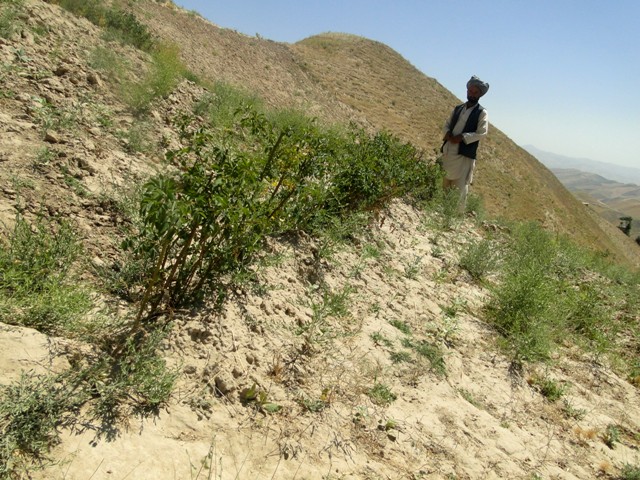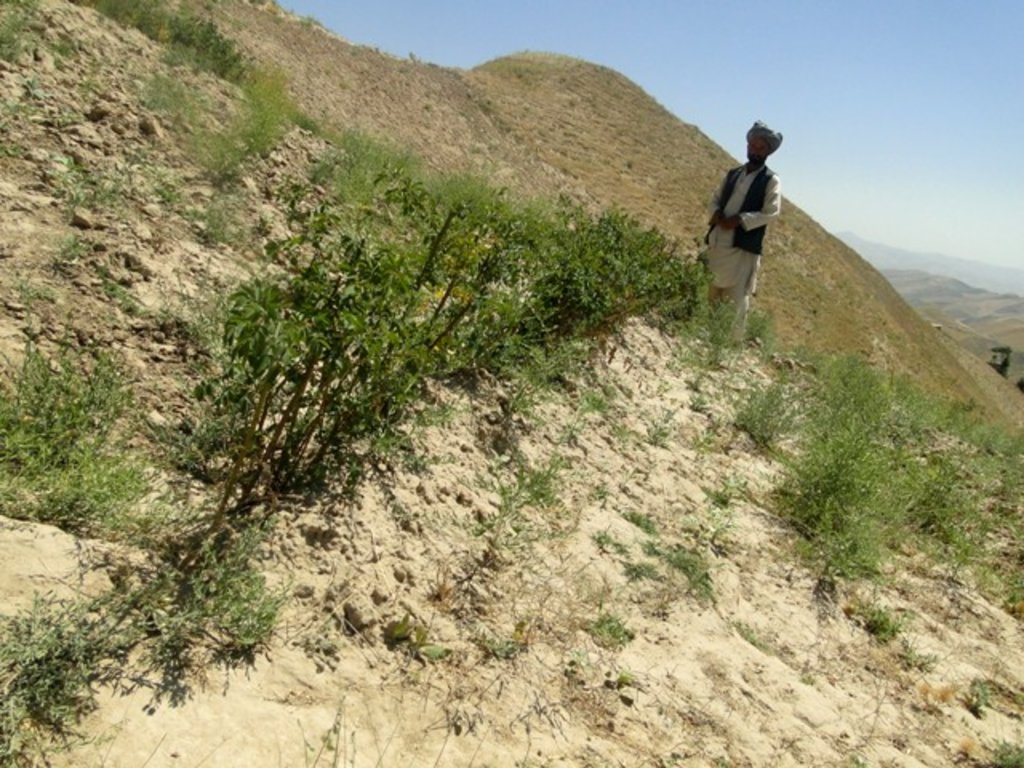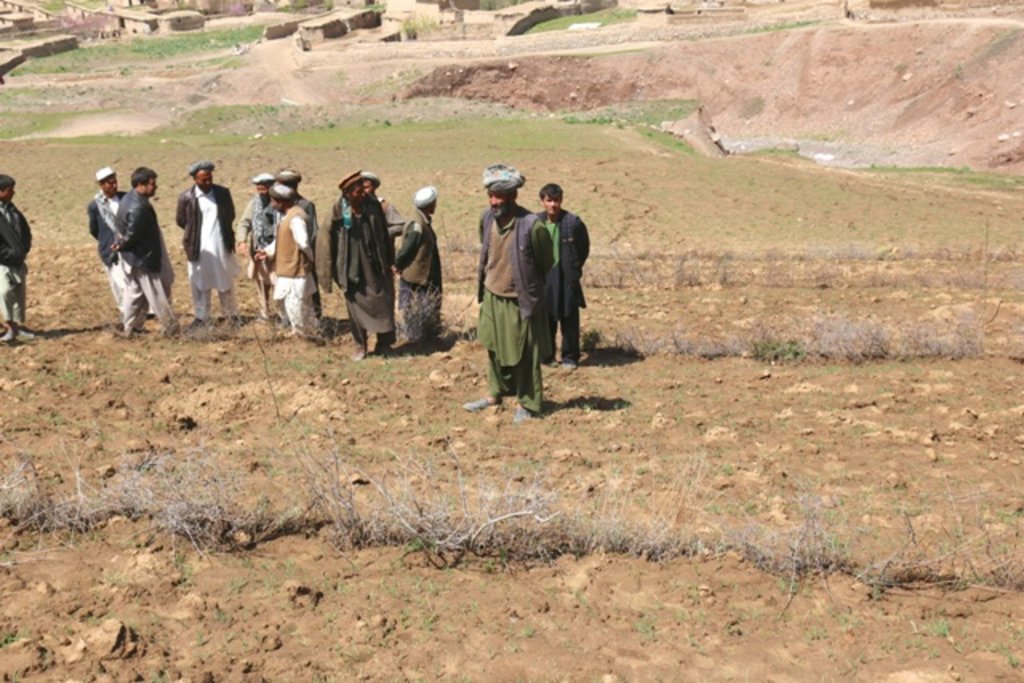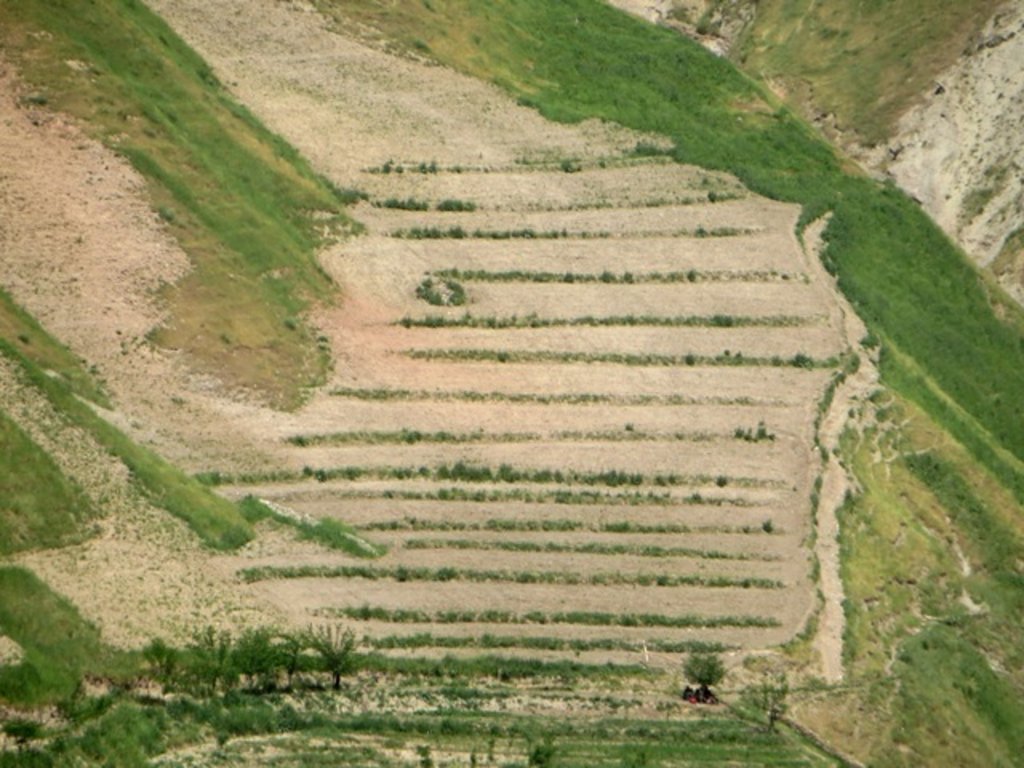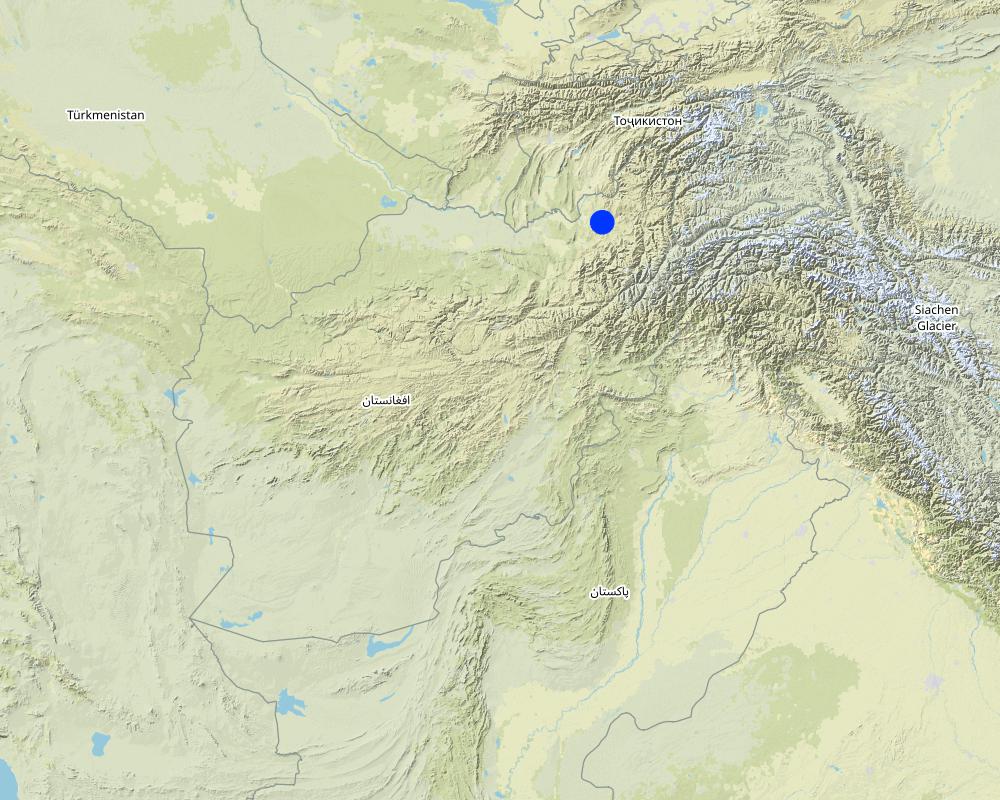Contour hedgerows of alfalfa in annual cropland [阿富汗]
- 创建:
- 更新:
- 编制者: Bettina Wolfgramm
- 编辑者: Roziya Kirgizbekova, Aslam Qadamov, Aqila Haidery
- 审查者: William Critchley
Khati sabz, Qamarbandi sabz
technologies_670 - 阿富汗
查看章节
全部展开 全部收起1. 一般信息
1.2 参与该技术评估和文件编制的资源人员和机构的联系方式
关键资源人
土地使用者:
Mohammad Azim Habibullah
Natural Resources Management Comittee (NRMC)
Sari Joy Village, Rustaq District, Takhor Province
阿富汗
SLM专业人员:
Maroofi Mia Jan
+93 700 019 054
mia.maroofi@gmail.com
Livelihood Improvement Program Takhor Afghanistan
Tdh Office Behind Jamai Masjed, Rustaq Town, Takhor Province
阿富汗
SLM专业人员:
Researcher:
有助于对技术进行记录/评估的项目名称(如相关)
Potential and limitations for improved natural resource management (NRM) in mountain communities in the Rustaq district, Afghanistan (Rustaq NRM Study)有助于对技术进行记录/评估的项目名称(如相关)
Livelihood Improvement Project Takhar, Afghanistan (LIPT)有助于对技术进行记录/评估的机构名称(如相关)
Terre des Hommes (Terre des Hommes) - 瑞士有助于对技术进行记录/评估的机构名称(如相关)
Swiss Agency for Development and Cooperation (DEZA / COSUDE / DDC / SDC) - 瑞士有助于对技术进行记录/评估的机构名称(如相关)
CDE Centre for Development and Environment (CDE Centre for Development and Environment) - 瑞士有助于对技术进行记录/评估的机构名称(如相关)
Bern University of Applied Sciences, School of Agricultural, Forest and Food Sciences (HAFL) - 瑞士1.3 关于使用通过WOCAT记录的数据的条件
(现场)数据是什么时候汇编的?:
27/10/2016
编制者和关键资源人员接受有关使用通过WOCAT记录数据的条件。:
是
1.4 所述技术的可持续性声明
这里所描述的技术在土地退化方面是否存在问题,导致无法被认为是一种可持续的土地管理技术?:
否
注释:
SLM practices documented in the frame of the Rustaq NRM study were established only recently (1-3 years ago). It is too early for a final judgment on the sustainability of these technologies within the human and natural environment of Chokar watershed.
2. SLM技术的说明
2.1 技术简介
技术定义:
Hedgerows are vegetative strips of perennial grasses, shrubs or legumes - such as alfalfa - located along contours across a slope. These vegetative strips form a barrier to halt soil erosion and improve soil fertility. Hedgerows of alfalfa also provide quality animal fodder for a period of 5-10 years.
2.2 技术的详细说明
说明:
Project supported implementation of hedgerows has taken place in the villages of Sari Joy and Jawaz Khana, located in Chokar watershed of Rustaq District in Northern Afghanistan. The Chokar watershed is a mountainous area situated between 600 m and 2,500 m above sea level. The climate is semi-arid with harsh and cold weather in winter and hot and dry summers. The annual precipitation in average years is 580mm. Land degradation affects all forms of land use and includes sparse vegetation cover, severe top soil erosion through rainfall runoff, and poor soil fertility. Unsustainable agricultural practices, and over-exploitation of the natural resources are adversely impacting the socio-economic well-being of local communities, as well as contributing to the risk of being adversely affected by drought, landslides and flash foods triggered by heavy rainfall. The data used for the documentation of the technology are based on field research conducted in Chokar watershed, namely in the villages of Sari Joy and Jawaz Khana. These villages represent the upper and the middle zone of Chokar watershed, respectively. They differ considerably in access to services and infrastructure, but in general are poorly served. The communities depend on land resources for sustaining their livelihoods. In a good year with high yields, wheat self-sufficiency lasts about 5 months. The three villages are home to ethnic Qarluq communities. Since 2012 the Livelihood Improvement Project Takhar (LIPT) implemented by Terre des hommes (Tdh) Switzerland has initiated a range of NRM interventions.
Hedgerows are vegetative strips, planted as contour barriers. In this case they are composed of the perennial legume alfalfa (sometime called lucerne: Medicago sativa), Using an A-frame, contours are defined and demarcated horizontally across the hillside. The distance between the contours depends on the slope gradient. For moderate slopes above 6%, and hilly slopes below 30%, the distance between the contours is 4-5 meters. Using such contouring measurements, a plot area of 0.2 ha is divided into 8 hedgerows along the slope. Once all the contours are established, the topsoil is levelled using a shovel. On each marked contour a soil ridge is created, some 10-20 cm high. On these ridges alfalfa seeds are sown to form the vegetative hedgerow. This stops soil wash, and prevents most of the rainfall runoff. The area between the grass strips is cropped with wheat. The hedgerows are protected for one year, to allow the alfalfa to become established.
Hedgerows were introduced in the local villages to promote low-cost land management practices, which are sustainable and well adapted to the local environmental conditions. Apart from reducing soil erosion, this new practice takes into account the needs of local people to improve soil fertility and increase agricultural yields. Local land users were trained to establish hedgerows on their own land using low amount of inputs. They were given the technical knowledge required. Over the past four years of implementation the land users report noticeable improvements on their plots. The soil is protected from erosion, and the households harvest wheat for the family and alfalfa for their livestock.
One of the key benefits of the technology is that it does not require many or costly inputs and it is relatively easy to establish without technical support. Improved production and availability of alfalfa is a primary benefit from the land users' point of view. They can harvest fodder from the plot for up to 10 years without reseeding.
Hedgerows are among the least labour-intensive SLM practices and thereby do not have a significant influence on the daily household workload of local women. This feature of the technology is perceived as its strength by many female family members.
2.3 技术照片
2.5 已应用该技术的、本评估所涵盖的国家/地区/地点
国家:
阿富汗
区域/州/省:
Takhar Province, Rustaq District
有关地点的进一步说明:
Sari Joy and Jawaz Khana Villages
注释:
This documentation is based on the experiences of SLM implementers from Sari Joy (3 plots) and Jawaz Khana, (3 plots) as compiled during FGDs. Additionally insights were gained through interviews in the villages on farmers experiences and observations of hedgerow plots, with both SLM implementers (5) and observers (7).
Map
×2.6 实施日期
如果不知道确切的年份,请说明大概的日期:
- 不到10年前(最近)
2.7 技术介绍
详细说明该技术是如何引入的:
- 通过项目/外部干预
注释(项目类型等):
Livelihood Improvement Project Takhar (LIPT) implemented by Terre des Hommes (Tdh) Switzerland, supported by Swiss Development Cooperation (SDC) from 2012-17
3. SLM技术的分类
3.1 该技术的主要目的
- 改良生产
- 减少、预防、恢复土地退化
3.2 应用该技术的当前土地利用类型

混合(作物/放牧/树木),包括农林
- 农林业
主要产品/服务:
Alfalfa, wheat (ferula in later years)
3.3 有关土地利用的更多信息
该技术所应用土地的供水:
- 雨养
每年的生长季节数:
- 1
3.4 该技术所属的SLM组
- 土壤肥力综合管理
- 横坡措施
3.5 技术传播
具体说明该技术的分布:
- 均匀地分布在一个区域
如果该技术均匀地分布在一个区域上,请注明覆盖的大致区域。:
- 0.1-1 平方千米
3.6 包含该技术的可持续土地管理措施

植物措施
- V1:乔木和灌木覆盖层

结构措施

管理措施
- M1:改变土地使用类型
注释:
After establishment activities the area is put on quarantine for one year.
3.7 该技术强调的主要土地退化类型

土壤水蚀
- Wt:表土流失/地表侵蚀

土壤风蚀
- Et:表土流失

生物性退化
- Bc:植被覆盖的减少
- Bq:数量/生物量减少
3.8 防止、减少或恢复土地退化
具体数量名该技术与土地退化有关的目标:
- 减少土地退化
4. 技术规范、实施活动、投入和成本
4.1 该技术的技术图纸
作者:
Aslam Qadamov; Roziya Kirgizbekova
日期:
15/02/2017
4.2 技术规范/技术图纸说明
Hedgerows are vegetative strips, planted as contour barriers. In this case they are composed of the perennial legume alfalfa (sometime called lucerne: Medicago sativa), Using an A-frame, contours are defined and demarcated horizontally across the hillside. The distance between the contours depends on the slope gradient. For moderate slopes above 6%, and hilly slopes below 30%, the distance between the contours is 4-5 meters. Using such contouring measurements, a plot area of 0.2 ha is divided into 8 hedgerows along the slope. Once all the contours are established, the topsoil is levelled using a shovel. On each marked contour a soil ridge is created, some 10-20 cm high. On these ridges alfalfa seeds are sown to form the vegetative hedgerow. This stops soil wash, and prevents most of the rainfall runoff. The area between the grass strips is cropped with wheat. The hedgerows are protected for one year, to allow the alfalfa to become established.
4.3 有关投入和成本计算的一般信息
具体说明成本和投入是如何计算的:
- 每个技术区域
注明尺寸和面积单位:
1 ha
具体说明成本计算所用货币:
- 美元
注明美元与当地货币的汇率(如相关):1美元=:
67.0
注明雇用劳工的每日平均工资成本:
5.2-5.3 USD per day
4.4 技术建立活动
| 活动 | 措施类型 | 时间 | |
|---|---|---|---|
| 1. | Selection of the area for establishing a hedgerow | 管理 | End of autumn |
| 2. | Design of the hedgerows using an A-frame | 结构性的 | End of autumn |
| 3. | Leveling of the land | 农业学的 | End of autumn |
| 4. | Alfalfa seed sowing | 植物性的 | End of winter (February) |
| 5. | Area under protection | 管理 | For one year |
4.5 技术建立所需要的费用和投入
| 对投入进行具体说明 | 单位 | 数量 | 单位成本 | 每项投入的总成本 | 土地使用者承担的成本% | |
|---|---|---|---|---|---|---|
| 劳动力 | Designing of the hedgerow using A-frame | person-day | 5.0 | 9.0 | 45.0 | |
| 劳动力 | Leveling the land | person-day | 25.0 | 5.3 | 132.5 | |
| 劳动力 | Ploughing the land with animal traction | person-day | 5.0 | 5.3 | 26.5 | |
| 劳动力 | Wheat and Alfalfa seed sowing | person-day | 10.0 | 5.3 | 53.0 | 100.0 |
| 设备 | Rake | piece | 1.0 | 5.3 | 5.3 | |
| 设备 | Shovel | piece | 1.0 | 3.8 | 3.8 | |
| 设备 | Twine | meter | 50.0 | 2.0 | 100.0 | |
| 设备 | A-frame | piece | 1.0 | 6.0 | 6.0 | |
| 植物材料 | Alfalfa seed | Kg | 17.5 | 0.42 | 7.35 | |
| 植物材料 | Wheat seed | Kg | 140.0 | 0.42 | 58.8 | 100.0 |
| 肥料和杀菌剂 | DAP | Kg | 250.0 | 0.9 | 225.0 | |
| 肥料和杀菌剂 | Urea | Kg | 250.0 | 0.45 | 112.5 | |
| 肥料和杀菌剂 | Herbicide | Liter | 50.0 | 0.25 | 12.5 | |
| 技术建立所需总成本 | 788.25 | |||||
如果土地使用者负担的费用少于100%,请注明由谁负担其余费用:
Livelihood Improvement Program in Takhar (LIPT) implemented by Terre des hommes (Tdh)
注释:
Costs calculated for a Technology area of 1ha was only done for the purpose of the WOCAT documentation. In reality SLM plots are on average 0.2-0.4 ha or 1-2 jiribs. Costs were simply multiplied by 2.5. The actual costs for a 1ha plot might be slightly different.
4.6 维护/经常性活动
| 活动 | 措施类型 | 时间/频率 | |
|---|---|---|---|
| 1. | Ploughing the land with animal traction (Men) | 农业学的 | |
| 2. | Wheat sowing | 农业学的 | |
| 3. | Weeding | 农业学的 | |
| 4. | Fertilizer application | 农业学的 | |
| 5. | Repair the damaged section of the hedgerow by adding soil | 结构性的 | End of winter (February/March) |
| 6. | Reseeding alfalfa in the repaired section | 植物性的 | End of winter (February/March) |
| 7. | Wheat and alfalfa harvesting and delivering | 农业学的 |
注释:
Sowing of alfalfa is done once in 5-10 years. The maintenance activities do not require reseeding of alfalfa every year (only where damaged). Mostly damage to hedgerows occur as a result of heavy rainfall and require maintenance work in early spring.
4.7 维护/经常性活动所需要的费用和投入(每年)
| 对投入进行具体说明 | 单位 | 数量 | 单位成本 | 每项投入的总成本 | 土地使用者承担的成本% | |
|---|---|---|---|---|---|---|
| 劳动力 | Ploughing the land with animal traction | person day | 5.0 | 5.3 | 26.5 | 100.0 |
| 劳动力 | Sowing of wheat | person day | 5.0 | 5.3 | 26.5 | 100.0 |
| 劳动力 | Weeding and Fertilizer application | person day | 5.0 | 5.3 | 26.5 | 100.0 |
| 劳动力 | Harvesting and delivering wheat and alfalfa | person day | 35.0 | 3.0 | 105.0 | 100.0 |
| 设备 | Sickle | Pcs | 1.0 | 2.25 | 2.25 | 100.0 |
| 设备 | Pitchfork | Pcs | 1.0 | 5.3 | 5.3 | 100.0 |
| 植物材料 | Alfalfa seed | kg | 1.0 | 0.42 | 0.42 | 100.0 |
| 植物材料 | Wheat seed | kg | 140.0 | 0.42 | 58.8 | 100.0 |
| 肥料和杀菌剂 | DAP | Kg | 250.0 | 0.9 | 225.0 | 100.0 |
| 肥料和杀菌剂 | Urea | Kg | 250.0 | 0.45 | 112.5 | 100.0 |
| 技术维护所需总成本 | 588.77 | |||||
如果土地使用者负担的费用少于100%,请注明由谁负担其余费用:
Livelihood Improvement Program in Takhar (LIPT) implemented by Terre des hommes (Tdh)
注释:
Costs calculated for a Technology area of 1ha was only done for the purpose of the WOCAT documentation. In reality SLM plots are on average 0.2-0.4 ha or 1-2 jiribs. Costs were simply multiplied by 2.5. The actual costs for a 1ha plot might be slightly different.
4.8 影响成本的最重要因素
描述影响成本的最决定性因素:
Due to the remoteness of the villages where the Technology has been implemented, all the inputs for establishment, such as plant material, fertilizers and agricultural tools are purchased in Rustaq town. The expenses for traveling and delivering the inputs affect the establishment costs.
5. 自然和人文环境
5.1 气候
年降雨量
- < 250毫米
- 251-500毫米
- 501-750毫米
- 751-1,000毫米
- 1,001-1,500毫米
- 1,501-2,000毫米
- 2,001-3,000毫米
- 3,001-4,000毫米
- > 4,000毫米
指定年平均降雨量(若已知),单位为mm:
564.00
有关降雨的规范/注释:
Average annual precipitation for the area was calculated with 564 mm, with minimum in dry years (2000 and 2001) of 270 mm and maximum in wet years (2009/2010) of 830 mm. The absolute maximum rainfall was calculated for 1986 with 1024 mm. The data series covers the period from 1979 to 2014.
注明所考虑的参考气象站名称:
Climate Forecast System Reanalysis (CFSR), http://rda.ucar.edu/pub/cfsr.html
农业气候带
- 半干旱
Derived from the publicly available dataset on length of growing period (LGP) (Fischer 2009 / IIASA-FAO). Internet link: http://tiles.arcgis.com/tiles/P8Cok4qAP1sTVE59/arcgis/rest/services/Length_of_growing_period/MapServer
5.2 地形
平均坡度:
- 水平(0-2%)
- 缓降(3-5%)
- 平缓(6-10%)
- 滚坡(11-15%)
- 崎岖(16-30%)
- 陡峭(31-60%)
- 非常陡峭(>60%)
地形:
- 高原/平原
- 山脊
- 山坡
- 山地斜坡
- 麓坡
- 谷底
垂直分布带:
- 0-100 m a.s.l.
- 101-500 m a.s.l.
- 501-1,000 m a.s.l.
- 1,001-1,500 m a.s.l.
- 1,501-2,000 m a.s.l.
- 2,001-2,500 m a.s.l.
- 2,501-3,000 m a.s.l.
- 3,001-4,000 m a.s.l.
- > 4,000 m a.s.l.
关于地形的注释和进一步规范:
-SLM implementers information provided in the Land User Protocol (LUP) during an FGD
-Elevation and slope statistics derived for terraced plots from ASTGTM. ASTGTM is the ASTER Global Digital Elevation Model V002 with a 30 m spatial resolution. More information on ASTGTM is available here: https://lpdaac.usgs.gov/node/1079. The data can be downloaded here: https://gdex.cr.usgs.gov/gdex/
5.3 土壤
平均土层深度:
- 非常浅(0-20厘米)
- 浅(21-50厘米)
- 中等深度(51-80厘米)
- 深(81-120厘米)
- 非常深(> 120厘米)
土壤质地(表土):
- 中粒(壤土、粉土)
土壤质地(地表以下> 20厘米):
- 中粒(壤土、粉土)
表土有机质:
- 低(<1%)
如有可能,附上完整的土壤描述或具体说明可用的信息,例如土壤类型、土壤酸碱度、阳离子交换能力、氮、盐度等。:
Hedgerows are implemented on light soil - a locally defined category for soil types. Light soil corresponds to moderately deep soil; medium topsoil texture; medium below surface texture and low topsoil organic matter.
5.4 水资源可用性和质量
地下水位表:
5-50米
地表水的可用性:
中等
水质(未处理):
良好饮用水
水的盐度有问题吗?:
否
该区域正在发生洪水吗?:
是
规律性:
偶然
关于水质和水量的注释和进一步规范:
Floods occur mainly during the rainy seasons in spring and autumn. Availability of surface water differs for the two study villages Sari Joy and Jawaz Khana. Sari Joy has relatively good surface water availability, also for drinking. Jawaz Khana has poor water both in quality and availability. Water has to be fetched from a lower lying stream.
5.5 生物多样性
物种多样性:
- 低
栖息地多样性:
- 低
5.6 应用该技术的土地使用者的特征
定栖或游牧:
- 定栖的
生产系统的市场定位:
- 生计(自给)
- 混合(生计/商业
非农收入:
- 收入的10-50%
- > 收入的50%
相对财富水平:
- 贫瘠
- 丰富
个人或集体:
- 个人/家庭
机械化水平:
- 手工作业
- 畜力牵引
性别:
- 女人
- 男人
土地使用者的年龄:
- 儿童
- 中年人
说明土地使用者的其他有关特征:
The land users in the area where the Technology is applied belong to the Uzbek ethnic minority group Qarluq. Although the men are generally the main land users, however, women and children also take active part in the related work. The functions of men and women are clearly distinguished within the Afghan society. At the same time within the family this division of work and functions also results in men and women working hand-in-hand. An improvement of the family’s livelihood situation is expected to positively affect all family members. While, it is recognized that the involvement of women is key in order to secure basic human rights for everyone, to achieve good governance, sustainable development, and to efficiently contribute to poverty reduction (SDC 2004), it is also clear that a context sensitive approach is of great importance.
Women in rural Afghanistan are involved in many production and income generating activities that contribute to the overall household income, however, very few women own resources such as land and livestock, and their income generating options are fewer in comparison to that of men.
5.7 应用该技术的土地使用者拥有或租用的平均土地面积
- < 0.5 公顷
- 0.5-1 公顷
- 1-2 公顷
- 2-5公顷
- 5-15公顷
- 15-50公顷
- 50-100公顷
- 100-500公顷
- 500-1,000公顷
- 1,000-10,000公顷
- > 10,000公顷
这被认为是小规模、中规模还是大规模的(参照当地实际情况)?:
- 中等规模的
5.8 土地所有权、土地使用权和水使用权
土地所有权:
- 个人,未命名
土地使用权:
- 个人
用水权:
- 社区(有组织)
注释:
Those who own a land and use water for irrigation are obliged to pay for water. The payment is made either in kind or in cash to Mirob - the person in charge of distributing water in the community. The amount of the payment varies from village to village.
6. 影响和结论性说明
6.1 该技术的现场影响
社会经济效应
生产
作物生产
注释/具体说明:
Wheat grows well on the plot where the contour strips support moisture retention, as well as prevent the seeds and fertilizers to be washed off.
饲料生产
注释/具体说明:
Alfalfa is produced on the hedgerows to ensure stable supply of livestock fodder.
畜牧生产
注释/具体说明:
The livestock of the household benefit from the improved production of alfalfa as a fodder crop.
木材生产
非木材林业生产
产品多样性
生产区域
社会文化影响
SLM/土地退化知识
注释/具体说明:
Land users learned how to implement SLM practices.
社会经济弱势群体的情况
注释/具体说明:
Female headed households are not included. Technology is implemented on private land, therefore people without land are excluded. However, they have the opportunity to earn income as a hired worker for the SLM implementers.
生态影响
水循环/径流
地表径流
土壤
土壤流失
生物多样性:植被、动物
植被覆盖
6.2 该技术的场外影响已经显现
下游洪水
下游淤积
缓冲/过滤能力
有关影响评估的意见:
Based on the Land User Protocols: SLM implementers were asked to rate the benefits from hedgerows individually. They were asked to indicate production increase of crops; fodder; animals; wood; non-wood forest products; increase in product diversity; or production area. The most important increase they rated with 3, the second most with 2, others with 1 point. Averages of the points given by all hedgerow implementers are reflected here.
Based on the Land User Protocols: Individual SLM implementers were asked to rate the on-site and off-site impacts of the Technology on water; soil; and vegetation. They were asked to indicate the strength of impacts with three, two or one points. Averages of the points given by all implementers are reflected here.
6.3 技术对渐变气候以及与气候相关的极端情况/灾害的暴露和敏感性(土地使用者认为的极端情况/灾害)
气候有关的极端情况(灾害)
气象灾害
| 该技术是如何应对的? | |
|---|---|
| 局地暴雨 | 非常好 |
气候灾害
| 该技术是如何应对的? | |
|---|---|
| 干旱 | 好 |
注释:
Based on the multi-criteria matrix: SLM implementers were asked to jointly discuss and rate how much the SLM technology reduced the lands vulnerability to drought and local rainstorms. Only vulnerability to the most prevalent climate extremes (drought and local rainstorms) was discussed. SLM technologies were rated as reducing vulnerability poorly, well, or very well. The average points reflected here are from multi-criteria matrixes compiled in three villages where the SLM technology had been implemented.
6.4 成本效益分析
技术收益与技术建立成本相比如何(从土地使用者的角度看)?
短期回报:
积极
长期回报:
积极
注释:
SLM implementers from three villages were asked to jointly discuss and rate the SLM technologies short term (1-3 years) and long-term (10 years) return. As most of the technologies have only been implemented 1-2 years ago, it is too early to compare benefits to maintenance costs. Farmers have little experience so far on the actual benefits of the SLM technologies. The ratings are mostly based on expected benefits and not on actual benefits.
6.5 技术采用
- 单例/实验
如若可行,进行量化(住户数量和/或覆盖面积):
16.4 ha
注释:
Based on the Land User Protocol: Individual SLM implementers were asked whether they received support for implementing the Technology. Each indicated the type of support he received from the proposed options: "Full Support 100%, Some Support, No Support 0%".
6.6 适应
最近是否对该技术进行了修改以适应不断变化的条件?:
否
6.7 该技术的优点/长处/机会
| 土地使用者眼中的长处/优势/机会 |
|---|
| The contour alfalfa strips preserve moisture and makes the land less vulnerable to dry spells. Longer moisture retention also helps the crop to grow better. |
| Production of livestock fodder such as alfalfa has been improved as observed by the land users. The hedgerow protects the soil from heavy rainfall, which would wash off the topsoil otherwise. |
| The establishment and maintenance activities are well compatible with the daily work of the land user compared to other more demanding field work. |
| Alfalfa can be grown without reseeding for up to 5 years and there is no need to buy alfalfa seeds every year. |
| Hedgerows are considered as the least labour-intensive technology for women and does not impact their daily household activities. |
| 编制者或其他关键资源人员认为的长处/优势/机会 |
|---|
| The establishment of hedgerows is not very technically demanding and does not require great technical knowledge |
6.8 技术的弱点/缺点/风险及其克服方法
| 土地使用者认为的弱点/缺点/风险 | 如何克服它们? |
|---|---|
| The costs of establishment are high for the land user, including the labour and material inputs | |
| The alfalfa strips need to be reseeded in 5-10 years and the land user may not have the seeds and has to buy them himself |
| 编制者或其他关键资源人员认为的弱点/缺点/风险 | 如何克服它们? |
|---|---|
| Hedgerows are among least popular practices among the land users and the adoption rates have been very low. The reasons behind might be the high establishments costs. |
7. 参考和链接
7.1 信息的方法/来源
- 实地考察、实地调查
No field work was conducted.
- 与土地使用者的访谈
Focus group discussions (FGD) were organized by the CDE team to collect information from SLM implementers. Total of 6 land users who have implemented hedgerows participated in the FGDs held in the villages of Sari Joy and Jawaz Khana.
Interviews were conducted by the HAFL team to collect information from persons representing all the three study villages. Very detailed interviews were conducted with 12 persons interested in hedgerows implementation, of which 5 persons are from households that already have implemented hedgerows.
- 与SLM专业人员/专家的访谈
Close collaboration took place during the compilation of this material with the technical staff of the LIPT project in Rustaq.
- 根据报告和其他现有文档进行编译
Information provided in the reports of the LIPT project in Rustaq served as an initial source of information during the preparatory phase and also solidifying the description of the technology and area of implementation. Other background papers on Afghanistan were referred to for general information on agriculture and natural resource management in Afghanistan.
7.2 参考可用出版物
标题、作者、年份、ISBN:
Guidelines for Focus Groups Discussions
标题、作者、年份、ISBN:
Methods section of the Rustaq NRM study
链接和模块
全部展开 全部收起链接
无链接
模块
无模块


